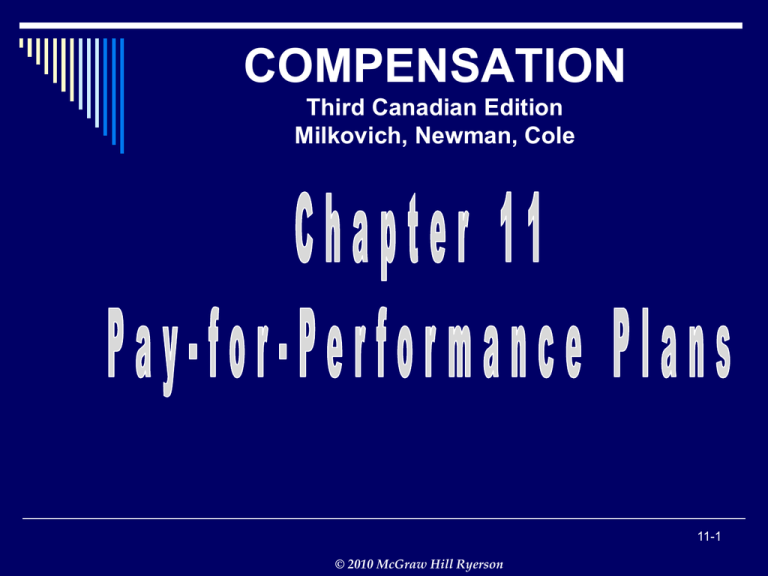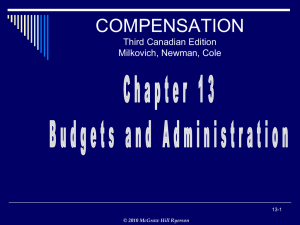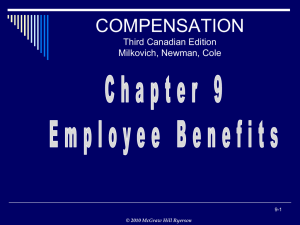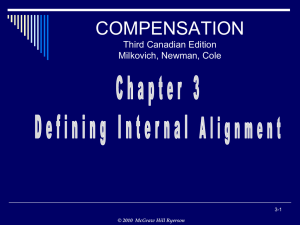Chapter 10
advertisement

COMPENSATION Third Canadian Edition Milkovich, Newman, Cole 11-1 © 2010 McGraw Hill Ryerson Pay-for-Performance Plans pay that varies with some measure of individual or organizational performance also called variable pay plans these plans have a positive impact on performance if they are designed well 11-2 © 2010 McGraw Hill Ryerson Short Term Pay-for-Performance Plans Merit Pay Lump-Sum Bonuses Individual Spot Awards Individual Incentives 11-3 © 2010 McGraw Hill Ryerson Individual Incentive Plans Method of Rate Determination Units of production per time period Pay constant function of production level Relationship between production level and pay Pay varies as function of production level (1) Straight piecework plan (3) Taylor differential piece rate system Time period per unit of production (2) Standard hour plan (4) Halsey 50 - 50 method Merrick multiple piece rate system 11-4 © 2010 McGraw Hill Ryerson Advantages of Individualized Incentive Plans substantial contribution to: increased productivity lower production costs increased earnings of workers less direct supervision is required to maintain output than under pay for time payment for results (if accompanied by improved organizational and work measurement) enable labour costs to be estimated more accurately than under pay for time helps costing and budgetary control 11-5 © 2010 McGraw Hill Ryerson Disadvantages of Individualized Incentive Plans (1 of 2) conflict between employees seeking to maximize output and managers concerned about deteriorating quality levels attempts to introduce new technology may be resisted by employees concerned about the impact on production standards reduced willingness of employees to suggest new production methods for fear of subsequent increases in production standards 11-6 © 2010 McGraw Hill Ryerson Disadvantages of Individualized Incentive Plans (2 of 2) increased complaints that equipment is poorly maintained, hindering employee efforts to earn larger incentives increased turnover among new employees discouraged by the unwillingness of experienced workers to cooperate in onthe-job training elevated levels of mistrust between workers and management 11-7 © 2010 McGraw Hill Ryerson Team / Group Incentive Plans Gain-Sharing Plans Profit Sharing Plans Earnings-at-Risk Plans 11-8 © 2010 McGraw Hill Ryerson Sample Group/Team Performance Measures (1 of 2) Customer-Focused Measures Financially-Focused Measures Time to Market Measures Value Creation On time delivery Revenue growth Cycle time Resource yields New product introductions Profit margins Customer Satisfaction Economic value added Measures Shareholder Return Market share Return on invested capital Customer satisfaction Return on sales / earnings Customer growth and retention Earnings per share Account penetration Growth in profitability 11-9 © 2010 McGraw Hill Ryerson Sample Group/Team Performance Measures (2 of 2) Capability-Focused Measures HR Capabilities Employee satisfaction Turnover rates Total recruitment costs Rate of progress on developmental plans Promotability index Staffing mix/head-count ratio Other Asset Capabilities Patents and copyrights Distribution systems Internal Process-Focused Measures Resource Utilization Budget-to-actual expenses Cost allocation ratios Reliability / rework Accuracy / error rates Safety rates Change Effectiveness Program implementation Teamwork effectiveness Service / quality index 11-10 © 2010 McGraw Hill Ryerson Different Types of Variable Pay Plans Cash Profit Sharing Stock Ownership or Options Balanced Scorecard Team / Group Incentives Productivity / Gain- Sharing 11-11 © 2010 McGraw Hill Ryerson Gain-Sharing Plans under gain-sharing plans, employees share in costsavings or productivity gains 11-12 © 2010 McGraw Hill Ryerson Key Elements in Designing a Gain-Sharing Plan strength of reinforcement productivity standards sharing the gains scope of the formula perceived fairness of the formula ease of administration production variability 11-13 © 2010 McGraw Hill Ryerson Three Gain-Sharing Formulas Scanlon Plan (single ratio volume) Rucker Plan Improshare Numerator of Payroll costs ratio (input factor) Denominator Net sales (+/of ratio inventories) (outcome factor) Labour cost Actual hours worked Value added Total standard value hours 11-14 © 2010 McGraw Hill Ryerson Profit-Sharing Plans variable pay plans requiring a corporate profit target to be met before any payouts occur 11-15 © 2010 McGraw Hill Ryerson Earnings-at-Risk Plans incentive plans sharing profits in successful years and reducing base pay in unsuccessful years 11-16 © 2010 McGraw Hill Ryerson Advantages of Group Incentive Plans positive impact on organization and individual performance of about 5 – 10 percent per year easier to develop performance measures than for individual plans signals that cooperation, both within and across groups, is a desired behaviour teamwork supported by most employees may increase participation of employees in decision making process 11-17 © 2010 McGraw Hill Ryerson Disadvantages of Group Incentive Plans line of sight may be lessened employees may find it more difficult to see how their individual performance affects their incentive payouts. may lead to increased turnover among top individual performers because they must share with lesser contributors increases compensation risk to employees because of lower income stability 11-18 © 2010 McGraw Hill Ryerson Long-Term Incentive Plans Employee Stock Ownership Plans (ESOPs) Stock Options Broad-Based Option Plans (BBOP) 11-19 © 2010 McGraw Hill Ryerson Special Groups in Compensation Management supervisors top management corporate directors professional employees sales staff contingent workers 11-20 © 2010 McGraw Hill Ryerson Components of an Executive Compensation Package 1. base salary 2. short-term (annual) incentives or bonuses 3. long-term incentives and capital appreciation plans 4. executive benefits 5. executive perquisites 11-21 © 2010 McGraw Hill Ryerson Examples of Long-Term Incentives for Executives 1. Appreciation-Based Plans stock options stock appreciation rights 2. Full-Share Plans restricted stock plans restricted stock units/phantom stock plans Deferred share units 3. Performance-Based Plans performance share / unit plans 11-22 © 2010 McGraw Hill Ryerson Pay Components for Professional Employees dual career ladders maturity curves performance bonuses attaining professional licenses perks flexible work schedules Campus-like environment 11-23 © 2010 McGraw Hill Ryerson Key Factors in Designing a Sales Compensation Plan the nature of the people who enter the sales profession organizational strategy competitor practices product/service being sold 11-24 © 2010 McGraw Hill Ryerson Key Issues in Contingent Workforce Compensation equity/fairness relative to permanent employees boundaryless careers 11-25 © 2010 McGraw Hill Ryerson Conclusion the design and effective administration of pay-for-performance plans is key to their success special employee groups compensation must address high potential for conflict in these jobs compensation treatment differs from that for other employees 11-26 © 2010 McGraw Hill Ryerson











